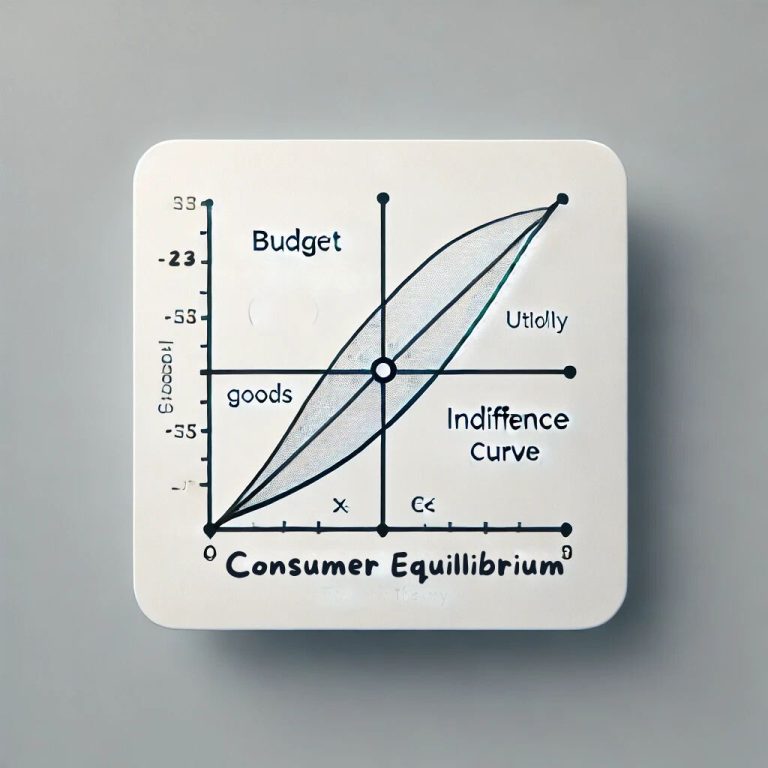Consumer equilibrium is that state where a consumer derives maximum satisfaction given his income and prices of commodities. Here, the consumer allocates his available resources in such a way that he cannot increase his utility by increasing or reducing his consumption of any commodity. In fact, understanding the concept of consumer equilibrium gives economists a lot of information on predicting the determination of changes in income, prices, and preferences. The article explores the importance, formulas, assumptions, and conditions required to achieve consumer equilibrium.
What is Consumer Equilibrium?
Consumer Equilibrium is the state at which a consumer is obtaining the highest possible level of satisfaction, or utility, out of the goods and services he or she purchases given a budget constraint. Again, this concept is based on the assumption of rational behavior for the consumer; namely, consumers wish to maximize utility. At this point, no reallocation of the consumer’s resources can lead to increased satisfaction.
In simple words, it is where the consumer attains the “best deal” as per her or his preference, income, and price of available goods. Such a balance lets consumers decide how much of each good they will buy.
Importance of Consumer Equilibrium
Consumer equilibrium is essential for multiple reasons:
- Decision Making:It will assist economists in understanding consumer choice behavior and predict how alterations in market conditions. For example, changes in income and price, will shift demand for goods and services.
- Market Demand: Individual consumer equilibrium is part of aggregate market demand for goods and services.
- Economic Efficiency: Since it attains consumer equilibrium, resources are used efficiently because consumers maximize utility to make the best decisions feasible.
The equilibrium also serves as a benchmark for evaluating the effects of economic policies on consumer welfare.
Consumer Equilibrium Formula
In the case of a single commodity, consumer equilibrium can be determined using the marginal utility approach. The consumer equilibrium formula is expressed as:
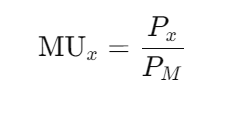
Where:
- (MU_x) is the marginal utility of good (x),
- (P_x) is the price of good (x),
- (P_M) is the price of money or the consumer’s marginal utility of income.
In equilibrium, the ratio of marginal utility to price should be equal for all goods. This ensures that each unit of money spent contributes equally to overall utility.
What is Consumer’s Break-Even Point?
The break-even point for the consumer is, therefore defined as the point at which the total expenditure by the consumer equals his or her total income, or where there is neither surplus nor deficit. It is the point at which the amount of spending by the consumer is equal to the income level, maximizing utility without exceeding the budget.
Graphically, the break-even point occurs at that point where the indifference curve is tangent to the consumer’s budget line. It thus stands for maximum possible satisfaction given the constraint of the income level.
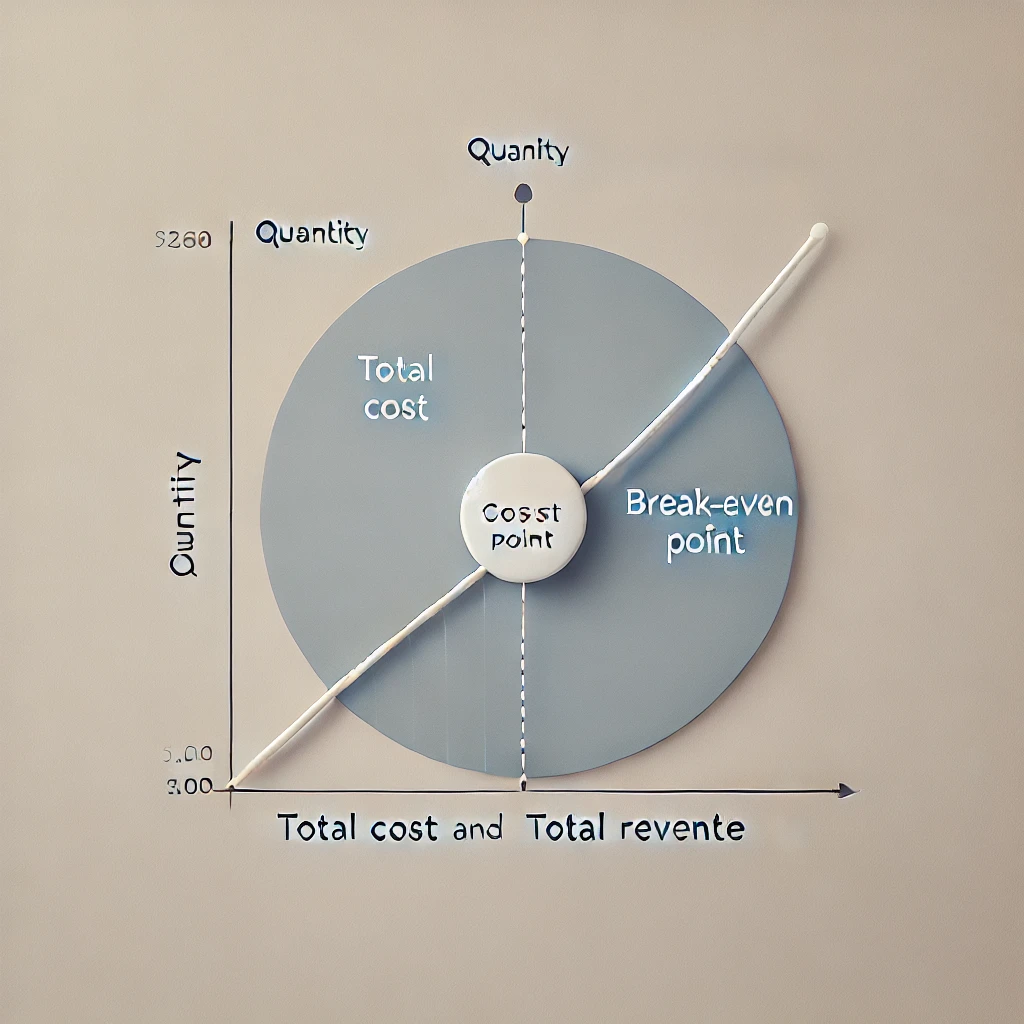
What are Assumptions for Attaining Consumer Equilibrium in Case of a Single Commodity?
Consumer equilibrium for a single commodity assumes:
- Rational Consumer: The consumer too rational and the objective to maximize utility.
- Diminishing Marginal Utility: The utility created by a unit of additional good decreases with an increase in the consumption level.
- Fixed Income: Consumer has fixed income that needs to be distributed.
- Constant Prices: The goods available are sold at constant prices.
- Divisible Goods: Goods are also divisible to achieve a fixed level of consumption.
These assumptions help simplify the analysis and allow economists to focus on how consumers distribute their resources in response to prices.
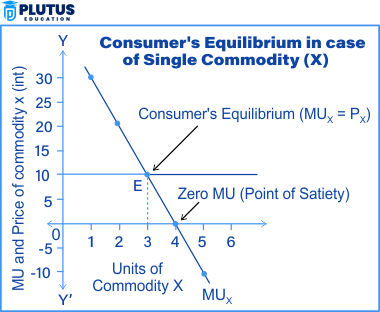
What are Assumptions for Attaining Consumer Equilibrium in Case of Two or More Commodities?
For multiple commodities, consumer equilibrium requires additional assumptions:
- Two or More Goods: The consumer buys at least two goods.
- Rationality and Utility Maximization: The consumer is rational in the sense that he seeks to maximize utility.
- Budget Constraint: The consumer has an income and thus is subject to budget constraint.
- Diminishing Marginal Utility for Each Commodity: For any commodity, marginal utility decreases with the increase in consumption of that commodity.
- Substitutability of Goods: A consumer can substitute between goods to maximize his utility since marginal utility per rupee spent on each good is equal.
What are Conditions for Consumer Equilibrium in Case of a Single Commodity?
For a single commodity, consumer equilibrium is achieved when the marginal utility per unit of expenditure on the commodity equals the price of that commodity. Mathematically, this is expressed as:
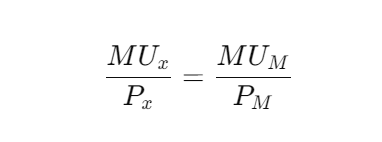
Where:
- (MU_x) is the marginal utility of the commodity.
- (P_x) is the price of the commodity.
- (MU_M) and (P_M) is the marginal utility and price of money, respectively.
This condition ensures that each additional unit of currency spent on the commodity yields an equal increment in utility.
What are Conditions for Consumer Equilibrium in Case of Two or More Commodities?
When a consumer purchases multiple goods, equilibrium occurs when the marginal utility per unit of expenditure is the same for all goods. The equal marginal principle is:

Where:
- (MU_x, MU_y, MU_z) are the marginal utilities of goods (x, y, z),
- (P_x, P_y, P_z) are their respective prices.
The consumer adjusts their consumption of the goods until the ratio of marginal utility to price is equal across all goods, thereby maximizing overall utility.
Consumer Equilibrium through Indifference Curve
In the indifference curve approach, consumer equilibrium arises where the consumer’s budget line is tangent to some indifference curve. This means the tangency indicates that the consumer has achieved maximum attainable satisfaction within the constraint of income.
Graphically, the budget line represents combinations of goods that can be afforded, and the indifference curve represents combinations that yield the same level of satisfaction. So the slope of the budget line equals the two good’s price ratio, while the slope of the indifference curve represents the marginal rate of substitution. At equilibrium, these slopes must be the same.
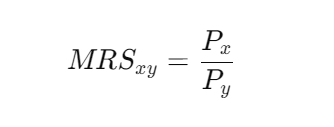
Where:
- (MRS_{xy}) is the marginal rate of substitution between goods (x) and (y).
- (P_x) and (P_y) are their respective prices.
This balance ensures that the consumer maximizes their utility by equalizing the rate at which they are willing to trade one good for another with the rate determined by market prices.
Consumer Equilibrium is the concept by which the optimum choices for consumers are ascertained given their budget and prices of goods. This concept is cardinal not only in the marginalist approach but also the indifference curve approach since it gives direction to behavior like that of the consumer or even the markets. Businesses and policymakers will be able to project the changes in demand for individual goods better through this concept and strategies enforcing towards economic efficiency.
Consumer Equilibrium FAQs
What is consumer equilibrium in microeconomics?
Consumer equilibrium refers to the point where a consumer maximizes their satisfaction given their budget and the prices of goods.
What is the formula for consumer equilibrium in the case of multiple goods?
The condition for consumer equilibrium across multiple goods is (\frac{MU_x}{P_x} = \frac{MU_y}{P_y}).
What is the consumer’s break-even point?
The consumer’s break-even point occurs when their total spending equals their income, optimizing their utility without overspending.
How is consumer equilibrium represented through indifference curves?
Consumer equilibrium is represented where the budget line is tangent to the highest attainable indifference curve.
What is the importance of diminishing marginal utility in consumer equilibrium?
Diminishing marginal utility ensures that as more units of a good are consumed, the additional satisfaction decreases, leading the consumer to spread their spending across various goods to maximize total utility.
